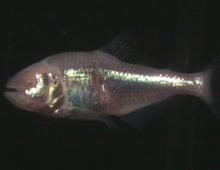Description: The body of the Blind cavefish is typical of the tetra (one of several species of small freshwater fish in the family Characidae) – elongated and compressed laterally. Overall, the color is a silvery-white to a pale brassy-silvery, except for a black lateral stripe that extends from the caudal base to the center of the caudal fin.
The pectorals are pinkish and the caudal fin is a warm yellow-gold with a black marginal band. The anal fins are pink to bright red with a black marginal border. The fins of the female are similar to the males, but less intense in color. This species is generally the dominant fish wherever it is found.
Size: Average adult length is 3.5 inches (8.9 cm). Females are larger and more robust, with length up to 4 inches (10 cm).
Behavior: No matter where this tetra is found, it seems to be associated with moving, clear waters and a gravel bottom. It is seldom encountered in deep waters, preferring to stay in the shallows and seldom seeks refuge in aquatic vegetation. In certain rivers and creeks, schools of Blind cavefish are so dense that the water appears black. A. fasciatus mexicanus typically school in large groups in the thousands. There is a great deal of intraspecific aggression within populations.
Diet: The Blind cavefish is mainly carnivorous, feeding on aquatic worms, snails, small fish and insects. Somewhat omnivorus in that they will also eat algae and plant matter.
Senses: Although they have lost their sight, blind cave fish have gained other senses that help them
live in the dark. A keen sense of smell guides them toward their favorite food sources. They are able to navigate by use of their lateral lines (system of sense organs) which are sensitive to changing water pressure, therefore preventing them from bumping into their surroundings.
Communication: An alarm substance is produced that causes fright reaction behavior in schools and individuals. This alarm behavior is as little as only being startled for a few minutes, but in extreme reactions, produces zig-zag movements, followed by hiding that can last for days.
Reproduction: Reproduction in these fish seems to show a lack of any courtship or display. Spawning males sit still in moving water or in vegetation and male spawning is preceded by a searching period. Ova and sperm are ejected while the pair turns their bodies, which are pressed together, upside down. Approximately 24 hours after spawning, the eggs will hatch into a small “tadpole-like” larvae stage. Growth is slow, with sexual maturity being reached in or about the sixth month.
Habitat/range: Their native range is from the southern United States of New Mexico and Texas, through Mexico into Guatemala. Blind cavefish are found in caverns and underground caves; in small streams and flowing rivers created from mountain runoffs and the running waters of lakes and rivers.
Status: They are not in danger of extinction; Least Concern (LC) by IUCN.



